Developing an Effective Talent Management System for Bank of Bahamas
VerifiedAdded on 2020/05/16
|23
|4865
|34
Report
AI Summary
This report focuses on developing an effective talent management system for managers at the Bank of Bahamas to enhance organizational performance, competitive advantage, and sustainable growth. The introduction highlights the bank's need to acquire and retain top talent in a competitive global economy, addressing issues of talent scarcity and the importance of strategic focus on leadership development. The literature review defines talent management, explores key drivers such as business performance and employee expectations, and examines critical dimensions like aligning individual and team goals. It also covers effective talent management processes, including strategic planning steps. The research design outlines the methodology, including the research philosophy, data collection methods, sampling strategy, limitations, and ethical considerations. The research plan details the organization of the study and includes a project plan or Gantt chart. The report aims to identify challenges, investigate drivers, and assess stakeholder perceptions to develop a tailored talent management system for the Bank of Bahamas. The report emphasizes the importance of talent management in today's business environment, where organizations spend a large percentage of their revenue on worker’s wages and benefits.
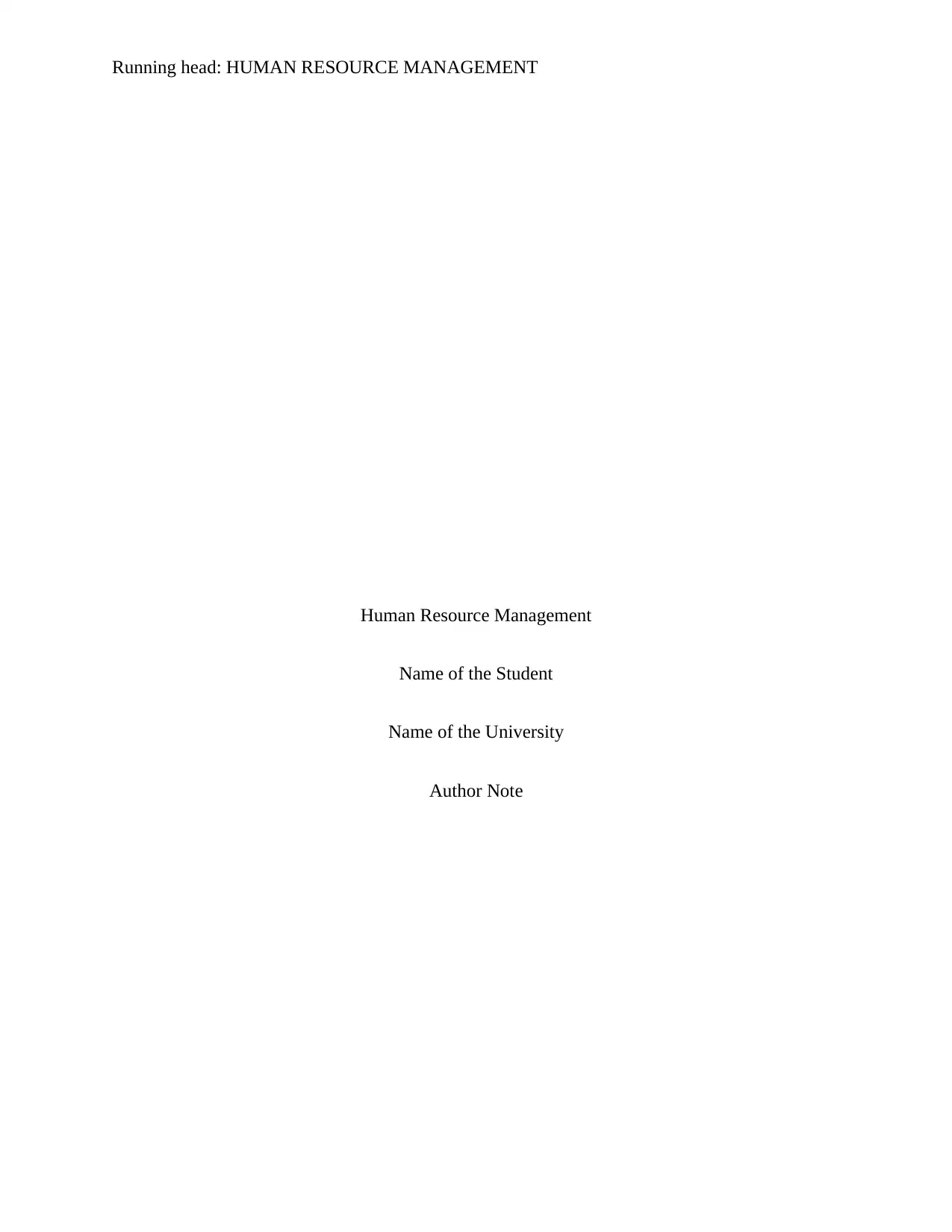
Running head: HUMAN RESOURCE MANAGEMENT
Human Resource Management
Name of the Student
Name of the University
Author Note
Human Resource Management
Name of the Student
Name of the University
Author Note
Paraphrase This Document
Need a fresh take? Get an instant paraphrase of this document with our AI Paraphraser
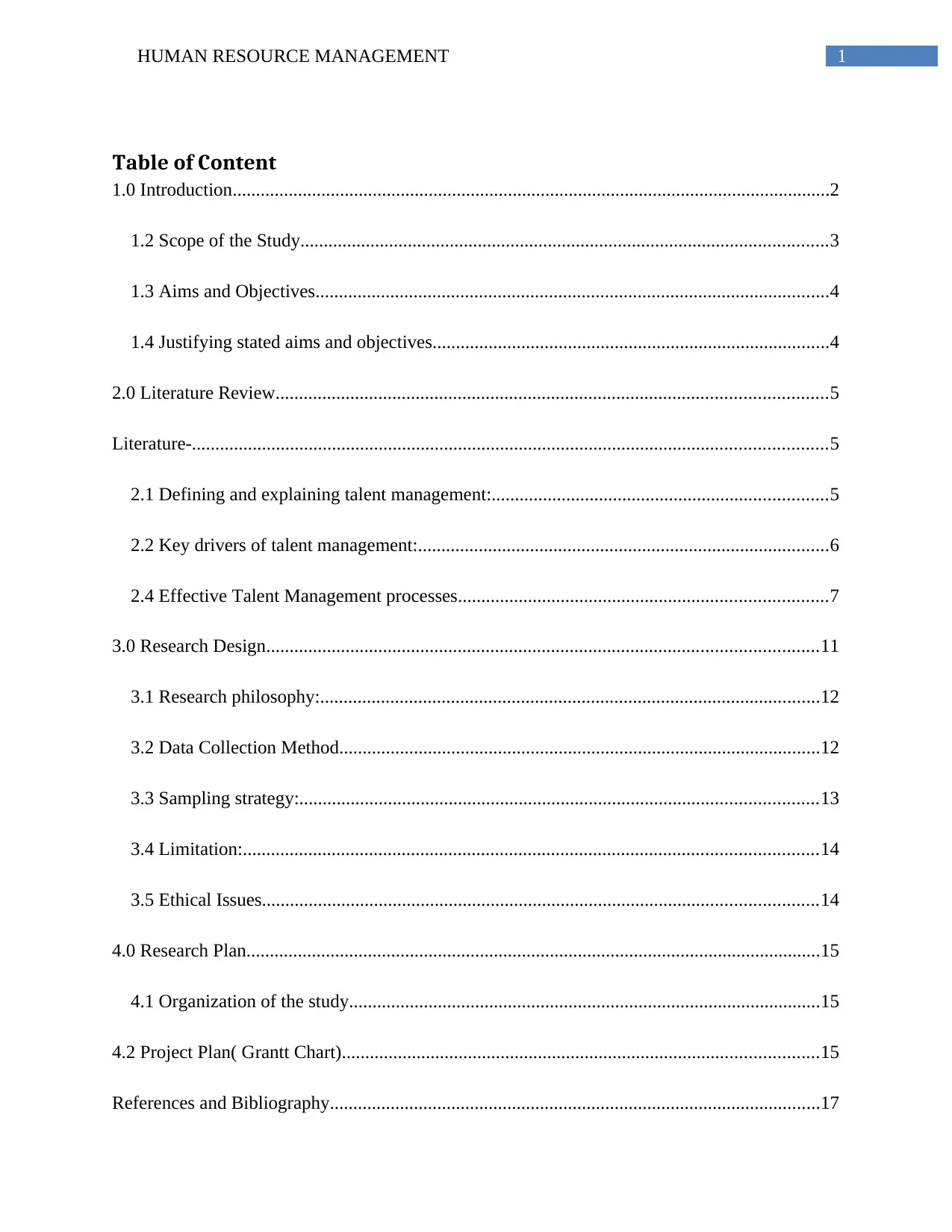
1HUMAN RESOURCE MANAGEMENT
Table of Content
1.0 Introduction................................................................................................................................2
1.2 Scope of the Study.................................................................................................................3
1.3 Aims and Objectives..............................................................................................................4
1.4 Justifying stated aims and objectives.....................................................................................4
2.0 Literature Review......................................................................................................................5
Literature-........................................................................................................................................5
2.1 Defining and explaining talent management:........................................................................5
2.2 Key drivers of talent management:........................................................................................6
2.4 Effective Talent Management processes...............................................................................7
3.0 Research Design......................................................................................................................11
3.1 Research philosophy:...........................................................................................................12
3.2 Data Collection Method.......................................................................................................12
3.3 Sampling strategy:...............................................................................................................13
3.4 Limitation:...........................................................................................................................14
3.5 Ethical Issues.......................................................................................................................14
4.0 Research Plan...........................................................................................................................15
4.1 Organization of the study.....................................................................................................15
4.2 Project Plan( Grantt Chart)......................................................................................................15
References and Bibliography.........................................................................................................17
Table of Content
1.0 Introduction................................................................................................................................2
1.2 Scope of the Study.................................................................................................................3
1.3 Aims and Objectives..............................................................................................................4
1.4 Justifying stated aims and objectives.....................................................................................4
2.0 Literature Review......................................................................................................................5
Literature-........................................................................................................................................5
2.1 Defining and explaining talent management:........................................................................5
2.2 Key drivers of talent management:........................................................................................6
2.4 Effective Talent Management processes...............................................................................7
3.0 Research Design......................................................................................................................11
3.1 Research philosophy:...........................................................................................................12
3.2 Data Collection Method.......................................................................................................12
3.3 Sampling strategy:...............................................................................................................13
3.4 Limitation:...........................................................................................................................14
3.5 Ethical Issues.......................................................................................................................14
4.0 Research Plan...........................................................................................................................15
4.1 Organization of the study.....................................................................................................15
4.2 Project Plan( Grantt Chart)......................................................................................................15
References and Bibliography.........................................................................................................17
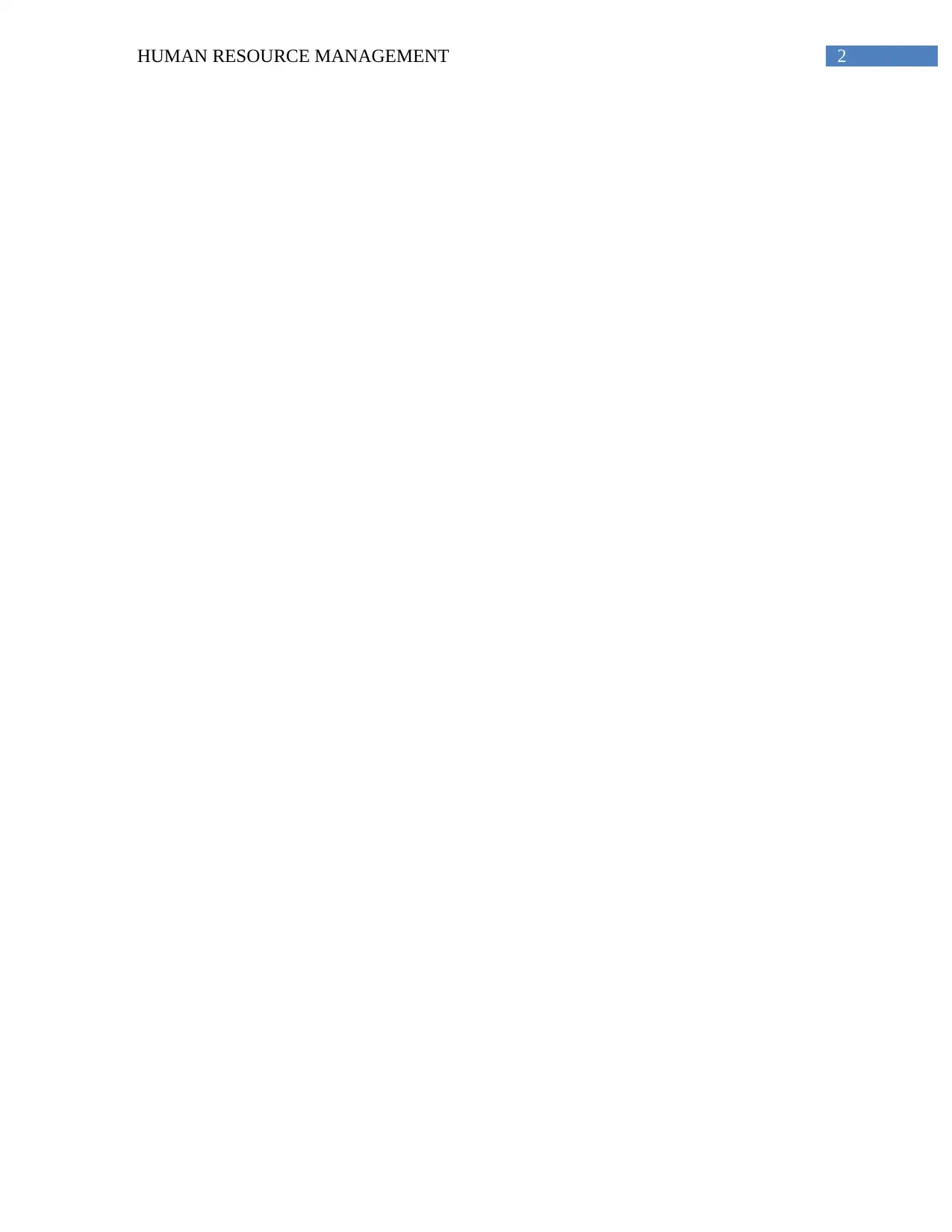
2HUMAN RESOURCE MANAGEMENT
⊘ This is a preview!⊘
Do you want full access?
Subscribe today to unlock all pages.

Trusted by 1+ million students worldwide
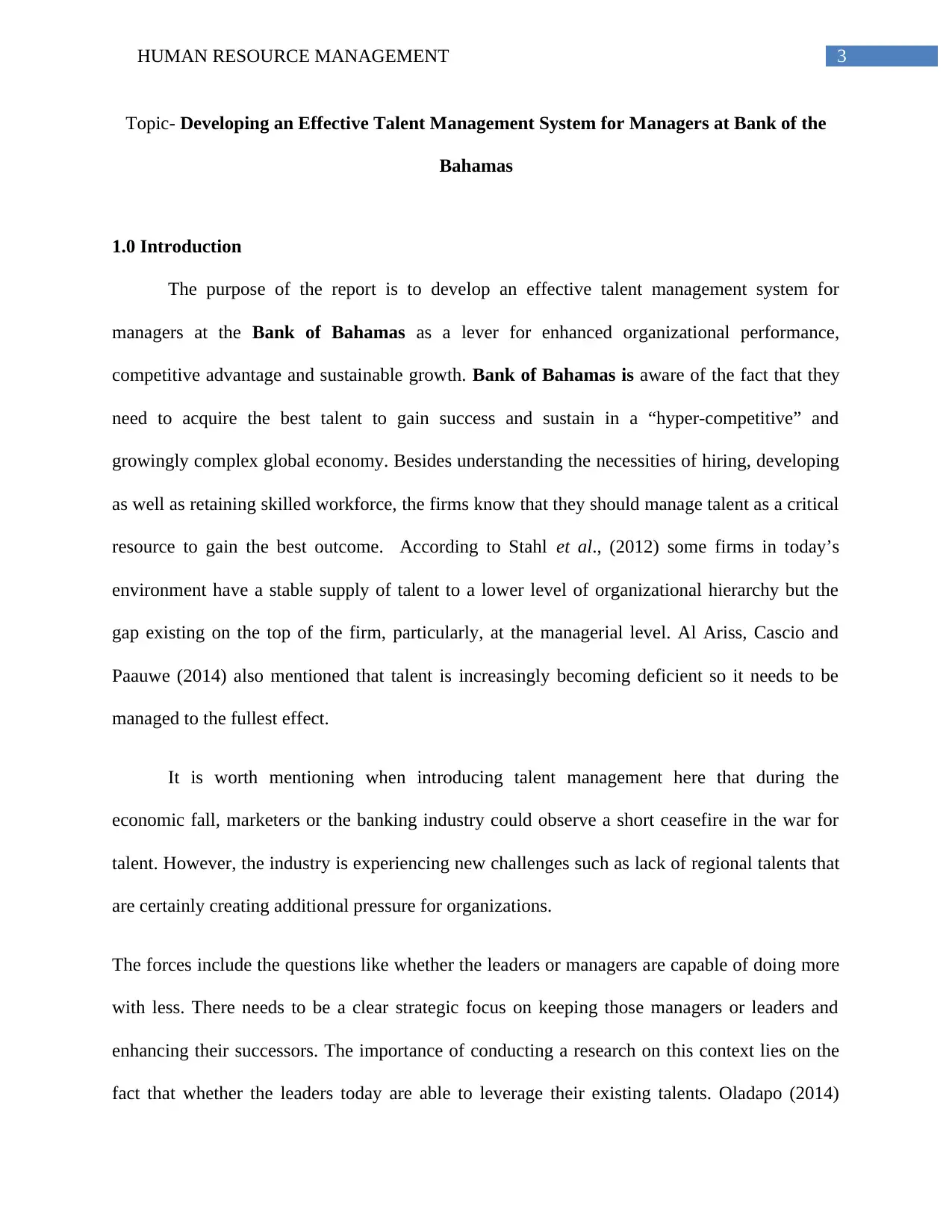
3HUMAN RESOURCE MANAGEMENT
Topic- Developing an Effective Talent Management System for Managers at Bank of the
Bahamas
1.0 Introduction
The purpose of the report is to develop an effective talent management system for
managers at the Bank of Bahamas as a lever for enhanced organizational performance,
competitive advantage and sustainable growth. Bank of Bahamas is aware of the fact that they
need to acquire the best talent to gain success and sustain in a “hyper-competitive” and
growingly complex global economy. Besides understanding the necessities of hiring, developing
as well as retaining skilled workforce, the firms know that they should manage talent as a critical
resource to gain the best outcome. According to Stahl et al., (2012) some firms in today’s
environment have a stable supply of talent to a lower level of organizational hierarchy but the
gap existing on the top of the firm, particularly, at the managerial level. Al Ariss, Cascio and
Paauwe (2014) also mentioned that talent is increasingly becoming deficient so it needs to be
managed to the fullest effect.
It is worth mentioning when introducing talent management here that during the
economic fall, marketers or the banking industry could observe a short ceasefire in the war for
talent. However, the industry is experiencing new challenges such as lack of regional talents that
are certainly creating additional pressure for organizations.
The forces include the questions like whether the leaders or managers are capable of doing more
with less. There needs to be a clear strategic focus on keeping those managers or leaders and
enhancing their successors. The importance of conducting a research on this context lies on the
fact that whether the leaders today are able to leverage their existing talents. Oladapo (2014)
Topic- Developing an Effective Talent Management System for Managers at Bank of the
Bahamas
1.0 Introduction
The purpose of the report is to develop an effective talent management system for
managers at the Bank of Bahamas as a lever for enhanced organizational performance,
competitive advantage and sustainable growth. Bank of Bahamas is aware of the fact that they
need to acquire the best talent to gain success and sustain in a “hyper-competitive” and
growingly complex global economy. Besides understanding the necessities of hiring, developing
as well as retaining skilled workforce, the firms know that they should manage talent as a critical
resource to gain the best outcome. According to Stahl et al., (2012) some firms in today’s
environment have a stable supply of talent to a lower level of organizational hierarchy but the
gap existing on the top of the firm, particularly, at the managerial level. Al Ariss, Cascio and
Paauwe (2014) also mentioned that talent is increasingly becoming deficient so it needs to be
managed to the fullest effect.
It is worth mentioning when introducing talent management here that during the
economic fall, marketers or the banking industry could observe a short ceasefire in the war for
talent. However, the industry is experiencing new challenges such as lack of regional talents that
are certainly creating additional pressure for organizations.
The forces include the questions like whether the leaders or managers are capable of doing more
with less. There needs to be a clear strategic focus on keeping those managers or leaders and
enhancing their successors. The importance of conducting a research on this context lies on the
fact that whether the leaders today are able to leverage their existing talents. Oladapo (2014)
Paraphrase This Document
Need a fresh take? Get an instant paraphrase of this document with our AI Paraphraser
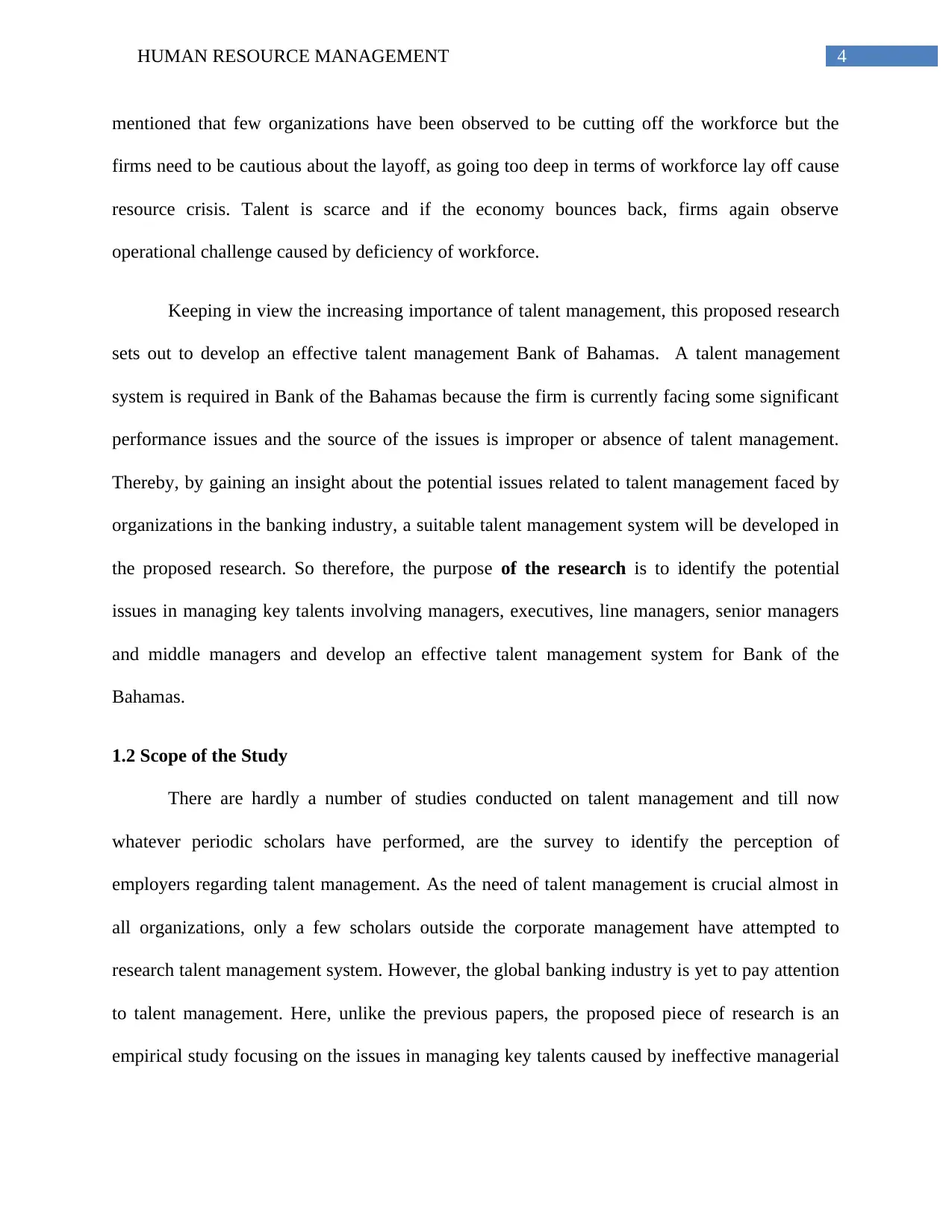
4HUMAN RESOURCE MANAGEMENT
mentioned that few organizations have been observed to be cutting off the workforce but the
firms need to be cautious about the layoff, as going too deep in terms of workforce lay off cause
resource crisis. Talent is scarce and if the economy bounces back, firms again observe
operational challenge caused by deficiency of workforce.
Keeping in view the increasing importance of talent management, this proposed research
sets out to develop an effective talent management Bank of Bahamas. A talent management
system is required in Bank of the Bahamas because the firm is currently facing some significant
performance issues and the source of the issues is improper or absence of talent management.
Thereby, by gaining an insight about the potential issues related to talent management faced by
organizations in the banking industry, a suitable talent management system will be developed in
the proposed research. So therefore, the purpose of the research is to identify the potential
issues in managing key talents involving managers, executives, line managers, senior managers
and middle managers and develop an effective talent management system for Bank of the
Bahamas.
1.2 Scope of the Study
There are hardly a number of studies conducted on talent management and till now
whatever periodic scholars have performed, are the survey to identify the perception of
employers regarding talent management. As the need of talent management is crucial almost in
all organizations, only a few scholars outside the corporate management have attempted to
research talent management system. However, the global banking industry is yet to pay attention
to talent management. Here, unlike the previous papers, the proposed piece of research is an
empirical study focusing on the issues in managing key talents caused by ineffective managerial
mentioned that few organizations have been observed to be cutting off the workforce but the
firms need to be cautious about the layoff, as going too deep in terms of workforce lay off cause
resource crisis. Talent is scarce and if the economy bounces back, firms again observe
operational challenge caused by deficiency of workforce.
Keeping in view the increasing importance of talent management, this proposed research
sets out to develop an effective talent management Bank of Bahamas. A talent management
system is required in Bank of the Bahamas because the firm is currently facing some significant
performance issues and the source of the issues is improper or absence of talent management.
Thereby, by gaining an insight about the potential issues related to talent management faced by
organizations in the banking industry, a suitable talent management system will be developed in
the proposed research. So therefore, the purpose of the research is to identify the potential
issues in managing key talents involving managers, executives, line managers, senior managers
and middle managers and develop an effective talent management system for Bank of the
Bahamas.
1.2 Scope of the Study
There are hardly a number of studies conducted on talent management and till now
whatever periodic scholars have performed, are the survey to identify the perception of
employers regarding talent management. As the need of talent management is crucial almost in
all organizations, only a few scholars outside the corporate management have attempted to
research talent management system. However, the global banking industry is yet to pay attention
to talent management. Here, unlike the previous papers, the proposed piece of research is an
empirical study focusing on the issues in managing key talents caused by ineffective managerial
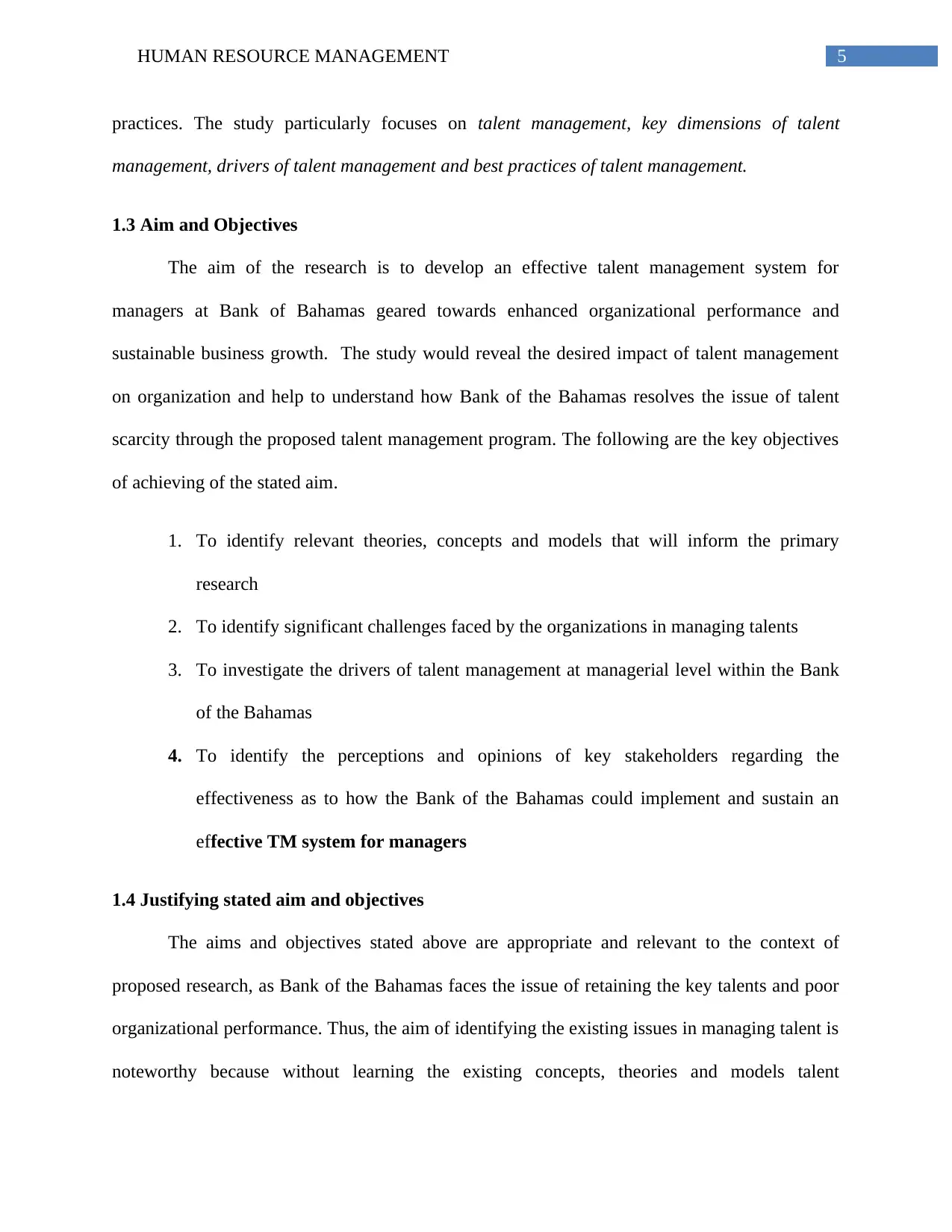
5HUMAN RESOURCE MANAGEMENT
practices. The study particularly focuses on talent management, key dimensions of talent
management, drivers of talent management and best practices of talent management.
1.3 Aim and Objectives
The aim of the research is to develop an effective talent management system for
managers at Bank of Bahamas geared towards enhanced organizational performance and
sustainable business growth. The study would reveal the desired impact of talent management
on organization and help to understand how Bank of the Bahamas resolves the issue of talent
scarcity through the proposed talent management program. The following are the key objectives
of achieving of the stated aim.
1. To identify relevant theories, concepts and models that will inform the primary
research
2. To identify significant challenges faced by the organizations in managing talents
3. To investigate the drivers of talent management at managerial level within the Bank
of the Bahamas
4. To identify the perceptions and opinions of key stakeholders regarding the
effectiveness as to how the Bank of the Bahamas could implement and sustain an
effective TM system for managers
1.4 Justifying stated aim and objectives
The aims and objectives stated above are appropriate and relevant to the context of
proposed research, as Bank of the Bahamas faces the issue of retaining the key talents and poor
organizational performance. Thus, the aim of identifying the existing issues in managing talent is
noteworthy because without learning the existing concepts, theories and models talent
practices. The study particularly focuses on talent management, key dimensions of talent
management, drivers of talent management and best practices of talent management.
1.3 Aim and Objectives
The aim of the research is to develop an effective talent management system for
managers at Bank of Bahamas geared towards enhanced organizational performance and
sustainable business growth. The study would reveal the desired impact of talent management
on organization and help to understand how Bank of the Bahamas resolves the issue of talent
scarcity through the proposed talent management program. The following are the key objectives
of achieving of the stated aim.
1. To identify relevant theories, concepts and models that will inform the primary
research
2. To identify significant challenges faced by the organizations in managing talents
3. To investigate the drivers of talent management at managerial level within the Bank
of the Bahamas
4. To identify the perceptions and opinions of key stakeholders regarding the
effectiveness as to how the Bank of the Bahamas could implement and sustain an
effective TM system for managers
1.4 Justifying stated aim and objectives
The aims and objectives stated above are appropriate and relevant to the context of
proposed research, as Bank of the Bahamas faces the issue of retaining the key talents and poor
organizational performance. Thus, the aim of identifying the existing issues in managing talent is
noteworthy because without learning the existing concepts, theories and models talent
⊘ This is a preview!⊘
Do you want full access?
Subscribe today to unlock all pages.

Trusted by 1+ million students worldwide
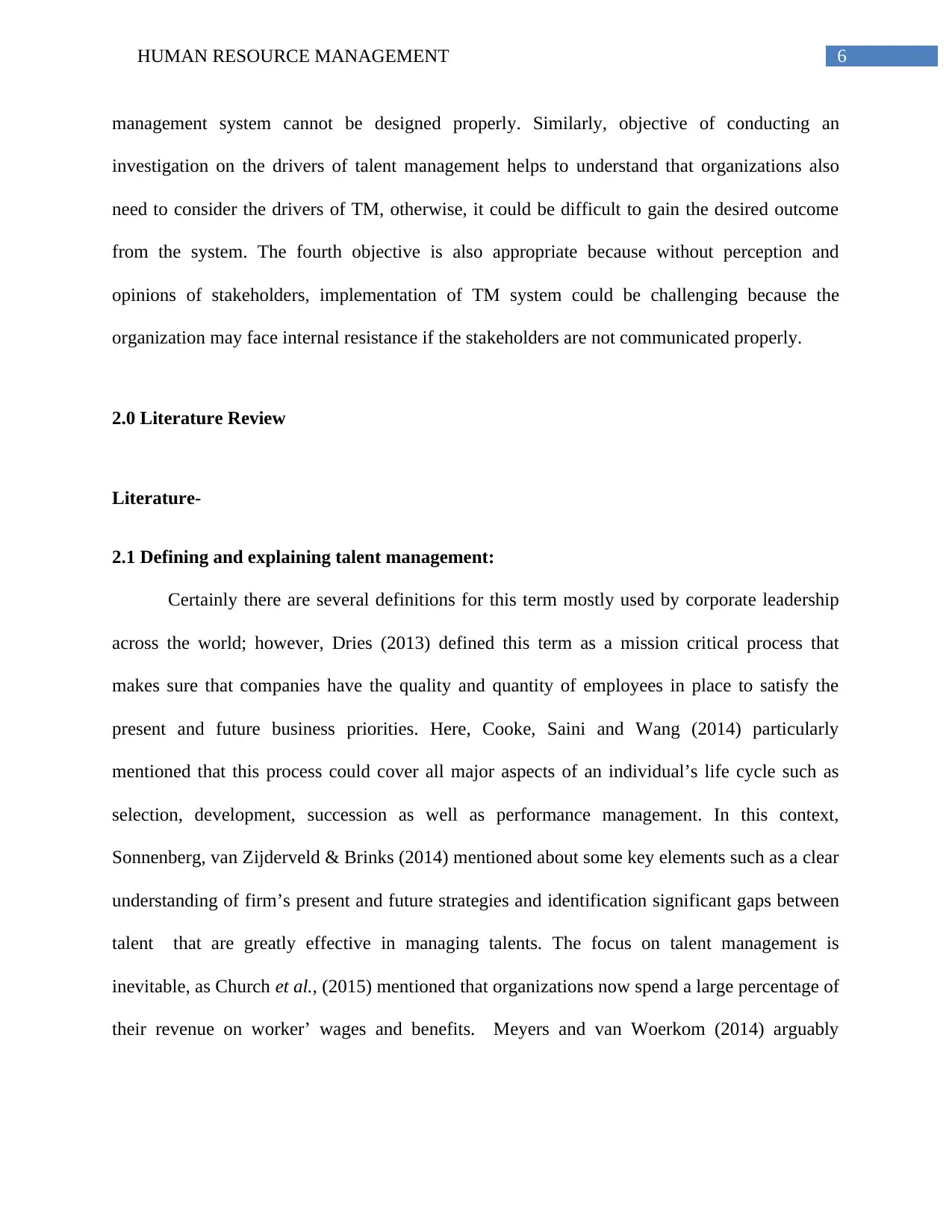
6HUMAN RESOURCE MANAGEMENT
management system cannot be designed properly. Similarly, objective of conducting an
investigation on the drivers of talent management helps to understand that organizations also
need to consider the drivers of TM, otherwise, it could be difficult to gain the desired outcome
from the system. The fourth objective is also appropriate because without perception and
opinions of stakeholders, implementation of TM system could be challenging because the
organization may face internal resistance if the stakeholders are not communicated properly.
2.0 Literature Review
Literature-
2.1 Defining and explaining talent management:
Certainly there are several definitions for this term mostly used by corporate leadership
across the world; however, Dries (2013) defined this term as a mission critical process that
makes sure that companies have the quality and quantity of employees in place to satisfy the
present and future business priorities. Here, Cooke, Saini and Wang (2014) particularly
mentioned that this process could cover all major aspects of an individual’s life cycle such as
selection, development, succession as well as performance management. In this context,
Sonnenberg, van Zijderveld & Brinks (2014) mentioned about some key elements such as a clear
understanding of firm’s present and future strategies and identification significant gaps between
talent that are greatly effective in managing talents. The focus on talent management is
inevitable, as Church et al., (2015) mentioned that organizations now spend a large percentage of
their revenue on worker’ wages and benefits. Meyers and van Woerkom (2014) arguably
management system cannot be designed properly. Similarly, objective of conducting an
investigation on the drivers of talent management helps to understand that organizations also
need to consider the drivers of TM, otherwise, it could be difficult to gain the desired outcome
from the system. The fourth objective is also appropriate because without perception and
opinions of stakeholders, implementation of TM system could be challenging because the
organization may face internal resistance if the stakeholders are not communicated properly.
2.0 Literature Review
Literature-
2.1 Defining and explaining talent management:
Certainly there are several definitions for this term mostly used by corporate leadership
across the world; however, Dries (2013) defined this term as a mission critical process that
makes sure that companies have the quality and quantity of employees in place to satisfy the
present and future business priorities. Here, Cooke, Saini and Wang (2014) particularly
mentioned that this process could cover all major aspects of an individual’s life cycle such as
selection, development, succession as well as performance management. In this context,
Sonnenberg, van Zijderveld & Brinks (2014) mentioned about some key elements such as a clear
understanding of firm’s present and future strategies and identification significant gaps between
talent that are greatly effective in managing talents. The focus on talent management is
inevitable, as Church et al., (2015) mentioned that organizations now spend a large percentage of
their revenue on worker’ wages and benefits. Meyers and van Woerkom (2014) arguably
Paraphrase This Document
Need a fresh take? Get an instant paraphrase of this document with our AI Paraphraser
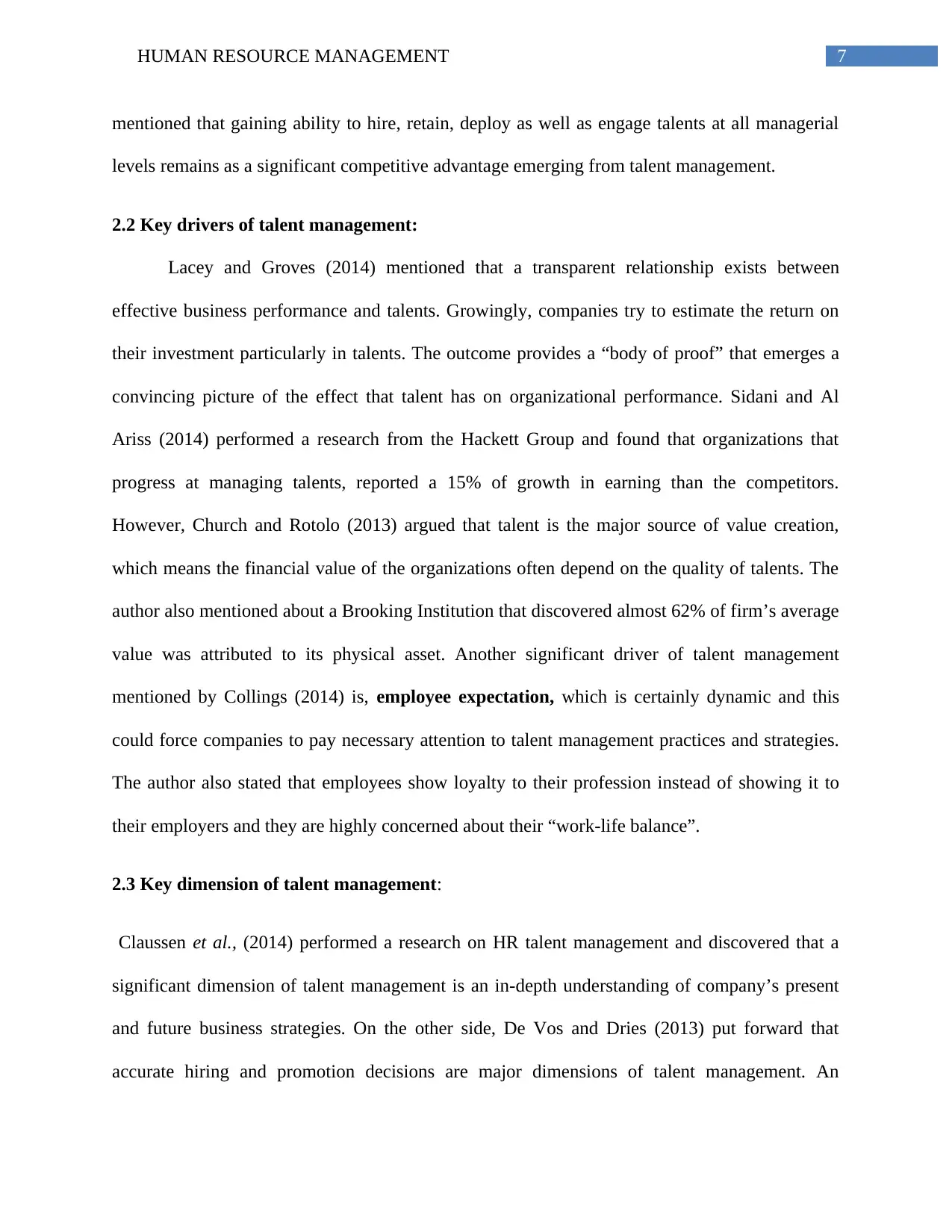
7HUMAN RESOURCE MANAGEMENT
mentioned that gaining ability to hire, retain, deploy as well as engage talents at all managerial
levels remains as a significant competitive advantage emerging from talent management.
2.2 Key drivers of talent management:
Lacey and Groves (2014) mentioned that a transparent relationship exists between
effective business performance and talents. Growingly, companies try to estimate the return on
their investment particularly in talents. The outcome provides a “body of proof” that emerges a
convincing picture of the effect that talent has on organizational performance. Sidani and Al
Ariss (2014) performed a research from the Hackett Group and found that organizations that
progress at managing talents, reported a 15% of growth in earning than the competitors.
However, Church and Rotolo (2013) argued that talent is the major source of value creation,
which means the financial value of the organizations often depend on the quality of talents. The
author also mentioned about a Brooking Institution that discovered almost 62% of firm’s average
value was attributed to its physical asset. Another significant driver of talent management
mentioned by Collings (2014) is, employee expectation, which is certainly dynamic and this
could force companies to pay necessary attention to talent management practices and strategies.
The author also stated that employees show loyalty to their profession instead of showing it to
their employers and they are highly concerned about their “work-life balance”.
2.3 Key dimension of talent management:
Claussen et al., (2014) performed a research on HR talent management and discovered that a
significant dimension of talent management is an in-depth understanding of company’s present
and future business strategies. On the other side, De Vos and Dries (2013) put forward that
accurate hiring and promotion decisions are major dimensions of talent management. An
mentioned that gaining ability to hire, retain, deploy as well as engage talents at all managerial
levels remains as a significant competitive advantage emerging from talent management.
2.2 Key drivers of talent management:
Lacey and Groves (2014) mentioned that a transparent relationship exists between
effective business performance and talents. Growingly, companies try to estimate the return on
their investment particularly in talents. The outcome provides a “body of proof” that emerges a
convincing picture of the effect that talent has on organizational performance. Sidani and Al
Ariss (2014) performed a research from the Hackett Group and found that organizations that
progress at managing talents, reported a 15% of growth in earning than the competitors.
However, Church and Rotolo (2013) argued that talent is the major source of value creation,
which means the financial value of the organizations often depend on the quality of talents. The
author also mentioned about a Brooking Institution that discovered almost 62% of firm’s average
value was attributed to its physical asset. Another significant driver of talent management
mentioned by Collings (2014) is, employee expectation, which is certainly dynamic and this
could force companies to pay necessary attention to talent management practices and strategies.
The author also stated that employees show loyalty to their profession instead of showing it to
their employers and they are highly concerned about their “work-life balance”.
2.3 Key dimension of talent management:
Claussen et al., (2014) performed a research on HR talent management and discovered that a
significant dimension of talent management is an in-depth understanding of company’s present
and future business strategies. On the other side, De Vos and Dries (2013) put forward that
accurate hiring and promotion decisions are major dimensions of talent management. An
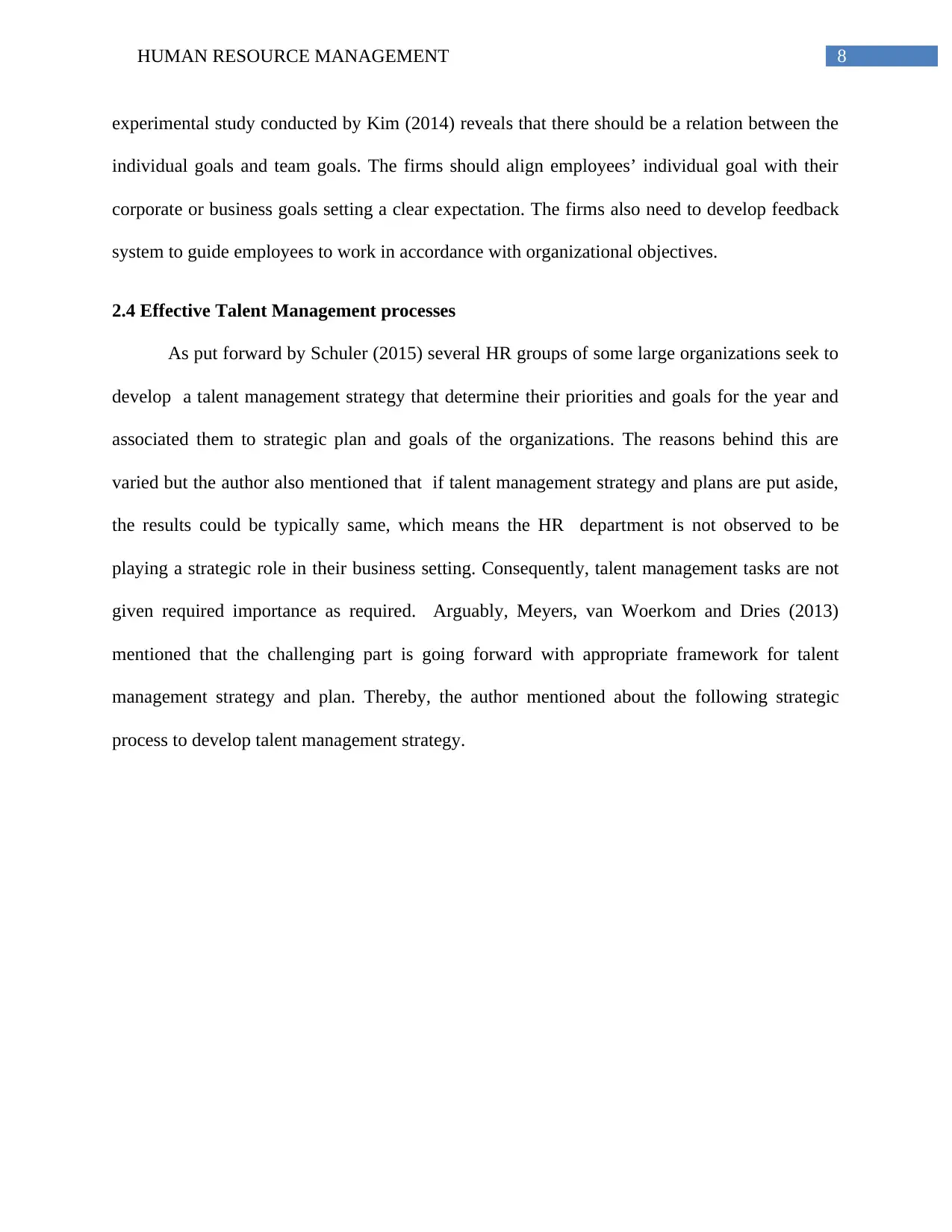
8HUMAN RESOURCE MANAGEMENT
experimental study conducted by Kim (2014) reveals that there should be a relation between the
individual goals and team goals. The firms should align employees’ individual goal with their
corporate or business goals setting a clear expectation. The firms also need to develop feedback
system to guide employees to work in accordance with organizational objectives.
2.4 Effective Talent Management processes
As put forward by Schuler (2015) several HR groups of some large organizations seek to
develop a talent management strategy that determine their priorities and goals for the year and
associated them to strategic plan and goals of the organizations. The reasons behind this are
varied but the author also mentioned that if talent management strategy and plans are put aside,
the results could be typically same, which means the HR department is not observed to be
playing a strategic role in their business setting. Consequently, talent management tasks are not
given required importance as required. Arguably, Meyers, van Woerkom and Dries (2013)
mentioned that the challenging part is going forward with appropriate framework for talent
management strategy and plan. Thereby, the author mentioned about the following strategic
process to develop talent management strategy.
experimental study conducted by Kim (2014) reveals that there should be a relation between the
individual goals and team goals. The firms should align employees’ individual goal with their
corporate or business goals setting a clear expectation. The firms also need to develop feedback
system to guide employees to work in accordance with organizational objectives.
2.4 Effective Talent Management processes
As put forward by Schuler (2015) several HR groups of some large organizations seek to
develop a talent management strategy that determine their priorities and goals for the year and
associated them to strategic plan and goals of the organizations. The reasons behind this are
varied but the author also mentioned that if talent management strategy and plans are put aside,
the results could be typically same, which means the HR department is not observed to be
playing a strategic role in their business setting. Consequently, talent management tasks are not
given required importance as required. Arguably, Meyers, van Woerkom and Dries (2013)
mentioned that the challenging part is going forward with appropriate framework for talent
management strategy and plan. Thereby, the author mentioned about the following strategic
process to develop talent management strategy.
⊘ This is a preview!⊘
Do you want full access?
Subscribe today to unlock all pages.

Trusted by 1+ million students worldwide
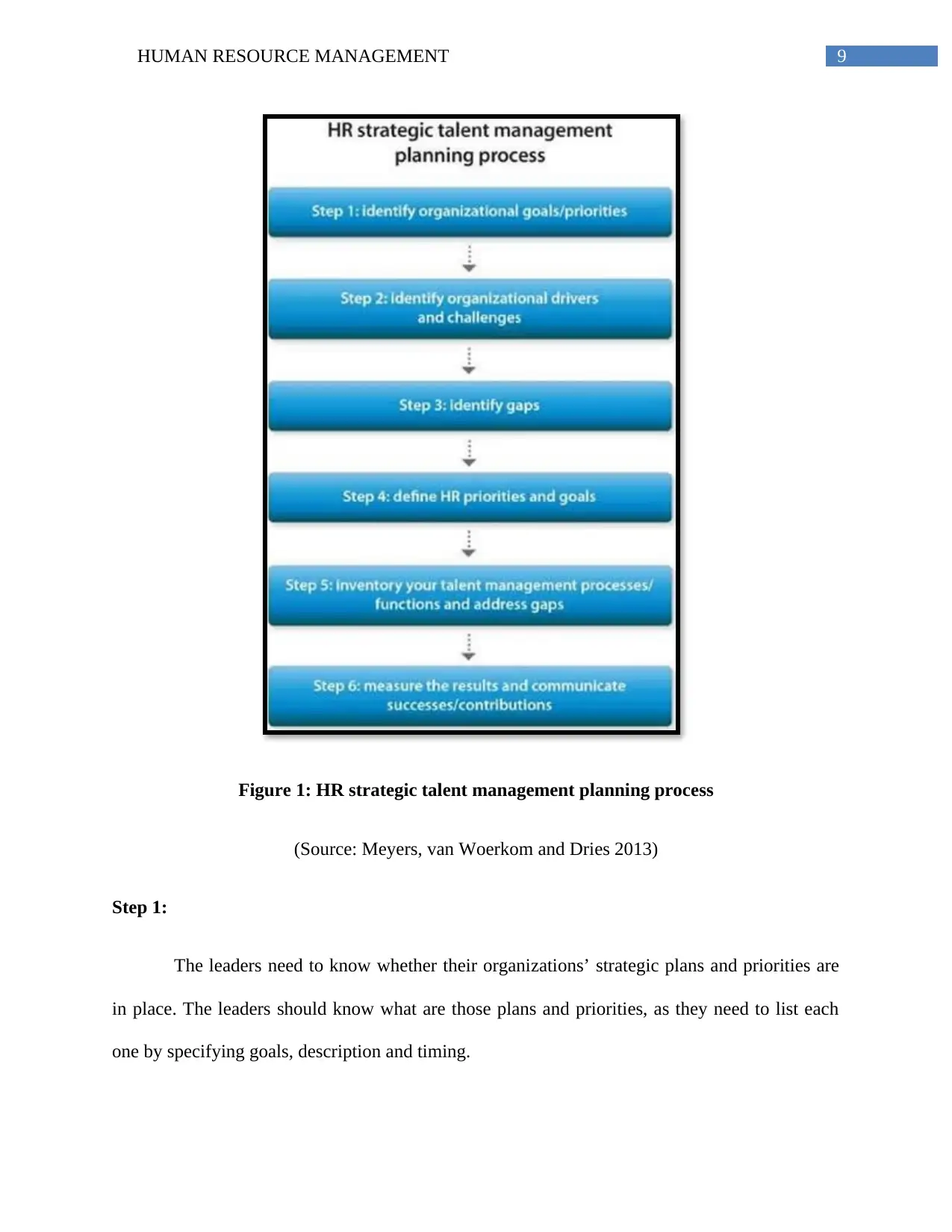
9HUMAN RESOURCE MANAGEMENT
Figure 1: HR strategic talent management planning process
(Source: Meyers, van Woerkom and Dries 2013)
Step 1:
The leaders need to know whether their organizations’ strategic plans and priorities are
in place. The leaders should know what are those plans and priorities, as they need to list each
one by specifying goals, description and timing.
Figure 1: HR strategic talent management planning process
(Source: Meyers, van Woerkom and Dries 2013)
Step 1:
The leaders need to know whether their organizations’ strategic plans and priorities are
in place. The leaders should know what are those plans and priorities, as they need to list each
one by specifying goals, description and timing.
Paraphrase This Document
Need a fresh take? Get an instant paraphrase of this document with our AI Paraphraser
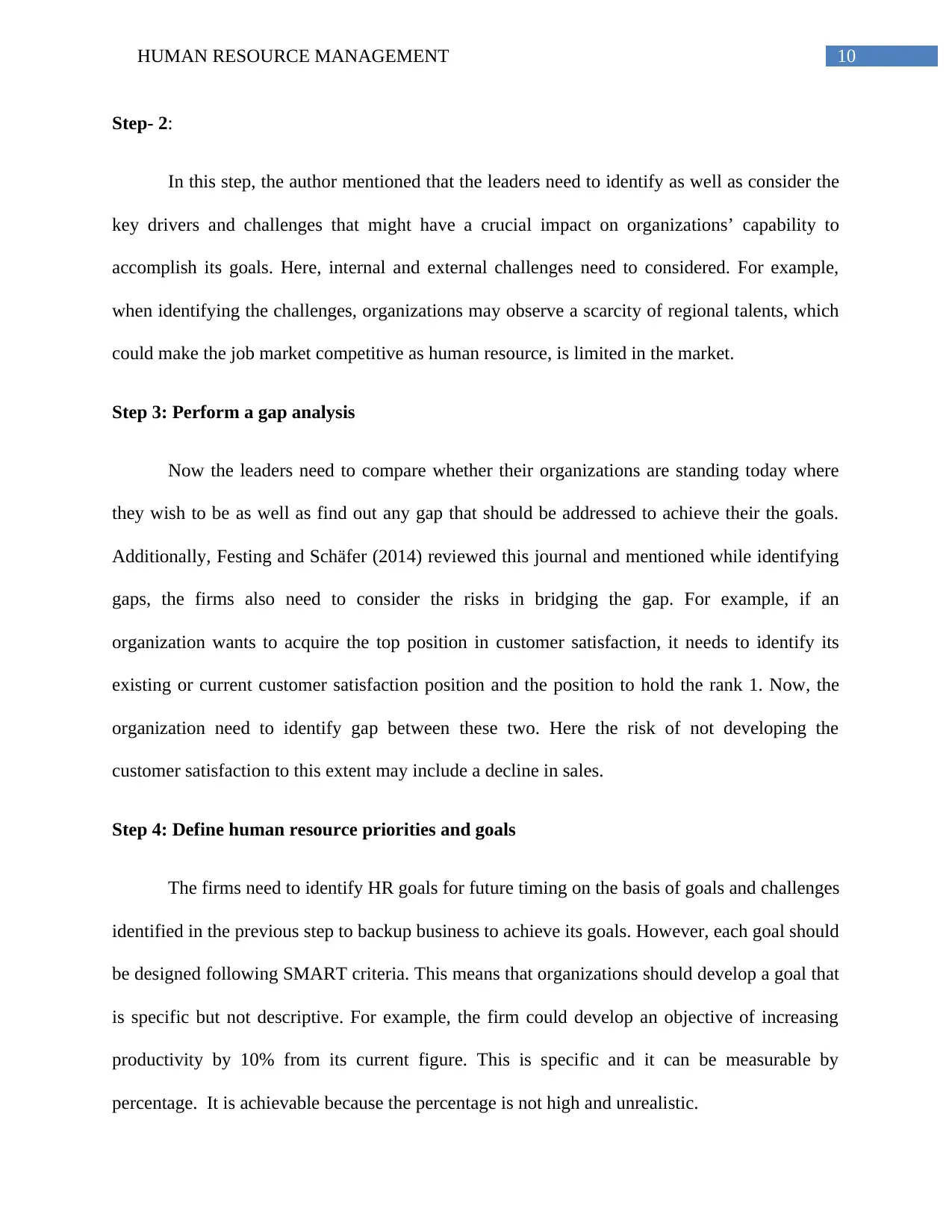
10HUMAN RESOURCE MANAGEMENT
Step- 2:
In this step, the author mentioned that the leaders need to identify as well as consider the
key drivers and challenges that might have a crucial impact on organizations’ capability to
accomplish its goals. Here, internal and external challenges need to considered. For example,
when identifying the challenges, organizations may observe a scarcity of regional talents, which
could make the job market competitive as human resource, is limited in the market.
Step 3: Perform a gap analysis
Now the leaders need to compare whether their organizations are standing today where
they wish to be as well as find out any gap that should be addressed to achieve their the goals.
Additionally, Festing and Schäfer (2014) reviewed this journal and mentioned while identifying
gaps, the firms also need to consider the risks in bridging the gap. For example, if an
organization wants to acquire the top position in customer satisfaction, it needs to identify its
existing or current customer satisfaction position and the position to hold the rank 1. Now, the
organization need to identify gap between these two. Here the risk of not developing the
customer satisfaction to this extent may include a decline in sales.
Step 4: Define human resource priorities and goals
The firms need to identify HR goals for future timing on the basis of goals and challenges
identified in the previous step to backup business to achieve its goals. However, each goal should
be designed following SMART criteria. This means that organizations should develop a goal that
is specific but not descriptive. For example, the firm could develop an objective of increasing
productivity by 10% from its current figure. This is specific and it can be measurable by
percentage. It is achievable because the percentage is not high and unrealistic.
Step- 2:
In this step, the author mentioned that the leaders need to identify as well as consider the
key drivers and challenges that might have a crucial impact on organizations’ capability to
accomplish its goals. Here, internal and external challenges need to considered. For example,
when identifying the challenges, organizations may observe a scarcity of regional talents, which
could make the job market competitive as human resource, is limited in the market.
Step 3: Perform a gap analysis
Now the leaders need to compare whether their organizations are standing today where
they wish to be as well as find out any gap that should be addressed to achieve their the goals.
Additionally, Festing and Schäfer (2014) reviewed this journal and mentioned while identifying
gaps, the firms also need to consider the risks in bridging the gap. For example, if an
organization wants to acquire the top position in customer satisfaction, it needs to identify its
existing or current customer satisfaction position and the position to hold the rank 1. Now, the
organization need to identify gap between these two. Here the risk of not developing the
customer satisfaction to this extent may include a decline in sales.
Step 4: Define human resource priorities and goals
The firms need to identify HR goals for future timing on the basis of goals and challenges
identified in the previous step to backup business to achieve its goals. However, each goal should
be designed following SMART criteria. This means that organizations should develop a goal that
is specific but not descriptive. For example, the firm could develop an objective of increasing
productivity by 10% from its current figure. This is specific and it can be measurable by
percentage. It is achievable because the percentage is not high and unrealistic.
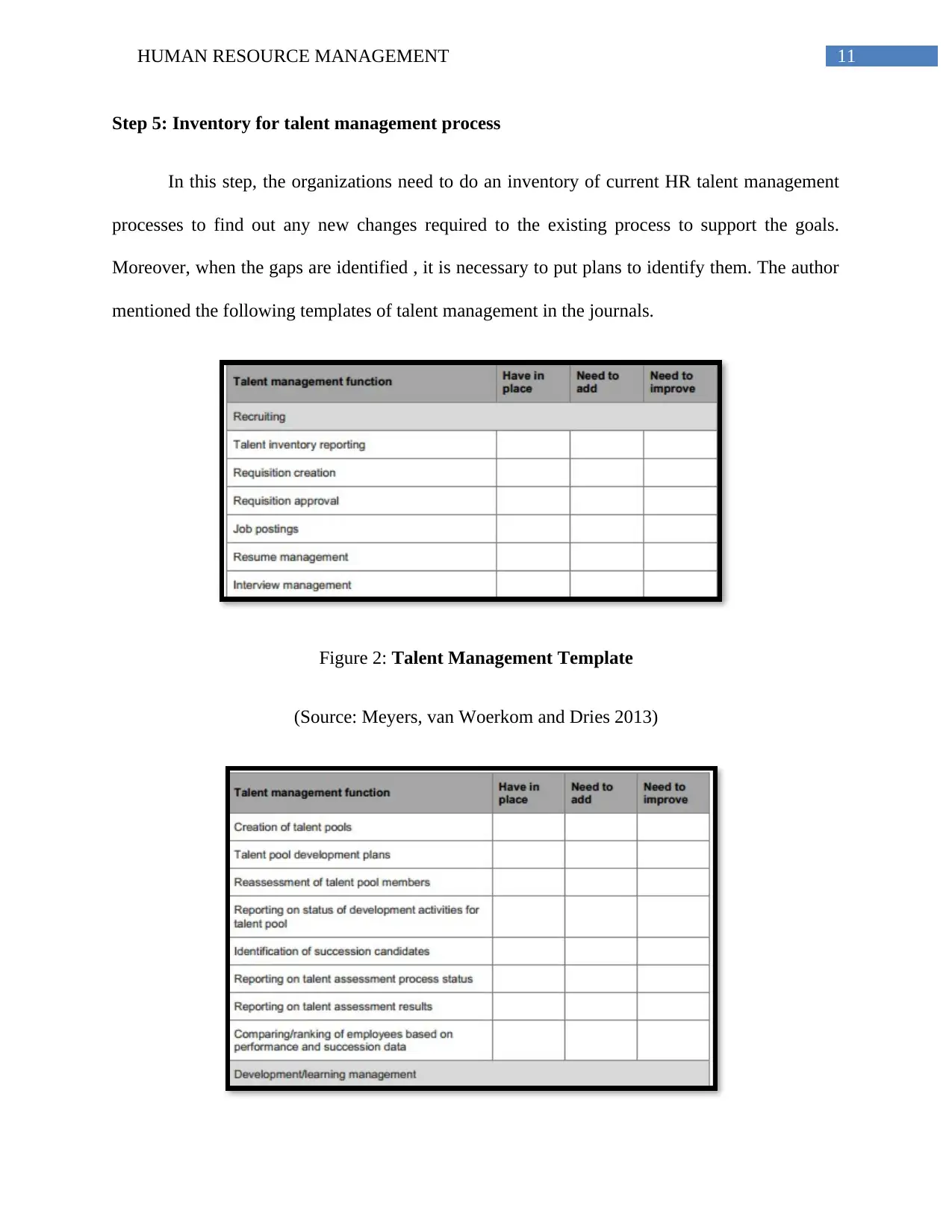
11HUMAN RESOURCE MANAGEMENT
Step 5: Inventory for talent management process
In this step, the organizations need to do an inventory of current HR talent management
processes to find out any new changes required to the existing process to support the goals.
Moreover, when the gaps are identified , it is necessary to put plans to identify them. The author
mentioned the following templates of talent management in the journals.
Figure 2: Talent Management Template
(Source: Meyers, van Woerkom and Dries 2013)
Step 5: Inventory for talent management process
In this step, the organizations need to do an inventory of current HR talent management
processes to find out any new changes required to the existing process to support the goals.
Moreover, when the gaps are identified , it is necessary to put plans to identify them. The author
mentioned the following templates of talent management in the journals.
Figure 2: Talent Management Template
(Source: Meyers, van Woerkom and Dries 2013)
⊘ This is a preview!⊘
Do you want full access?
Subscribe today to unlock all pages.

Trusted by 1+ million students worldwide
1 out of 23
Related Documents
Your All-in-One AI-Powered Toolkit for Academic Success.
+13062052269
info@desklib.com
Available 24*7 on WhatsApp / Email
![[object Object]](/_next/static/media/star-bottom.7253800d.svg)
Unlock your academic potential
Copyright © 2020–2025 A2Z Services. All Rights Reserved. Developed and managed by ZUCOL.





